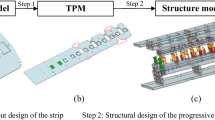Abstract
The designing of stamping dies is a complex process influenced by numerous design parameters, which can be classified into independent and dependent parameters. Before starting the design process a designer must identify, analyze, and calculate these parameters needing a wide range of knowledge. The design task is then accomplished on the basis of these parameter values that must be incorporated into the die design’s elements, in order to achieve workable and quality designs. Since most of the 3D CADs provide insufficient help in this regard, an automated system has been developed in CATIA V5 for the automatic designing of compound dies intended for production of various washer configurations. This system operates on the basis of an integrated design knowledge embedded inside washer, strip, and die-parts’ generative models using user parameters and a programmatically established relations between them. The use of this system significantly shortens the design time, and denotes design quality.









Similar content being viewed by others
References
Altan T (1987) Design and manufacturing of dies and molds. Ann CIRP 36(2):455–462
Boljanovic V (2004) Sheet metal forming processes and die design. Industrial Press Inc, New York
Cheok BT, Nee AYC (1998) Trends and developments in the automation of design and manufacture of dies for metal stampings. J Mater Process Technol 75:240–252
Cuckovic S, Devedzic G, Ghionea I (2010) Automatic determination of grinding tool profile for helical surfaces machining using catia/vb interface. U.P.B Sci Bull Ser D 72:1454–2358
Fallbohmer P, Altan T, Tonshoff H-K, Nakagawa T (1996) Survey of the die and mold manufacturing industry. J Mater Process Technol 59:158–168
Groover MP (2010) Modern manufacturing materials, processes, and systems. Wiley, Hoboken
Jiang RD, Lauw BT, Nee AYC (2006) Insert design automation for progressive dies. Intern J Adv Manuf Technol 28:279–285
Kumar S, Singh R, Sekhon GS (2006) CCKBS: a component check knowledge-based system for assessing manufacturability of sheet metal parts. J Mater Process Technol 172:64–69
Lin BT, Chan CK, Wang JC (2008) A knowledge-based parametric design system for drawing dies. Intern J Adv Manuf Technol 36:671–680
Lin BT, Hsu SH (2008) Automated design system for drawing die. Expert Syst Appl 34:1586–1598
Paquin JR, Crowley RE (1986) Die design fundamentals. Industrial Press, New York
Potocnik D, Ulbin M, Dolsak B (2012) Knowledge-based system for supporting the design of a plate-press. J Comput Inf Sci Eng 12:024502
Potocnik D, Pesan B, Balic J, Ulbin M (2011) Intelligent system for the automatic calculation of stamping parameters. Adv Prod Eng Manag 6:129–137
Salin F, Burry J (2010) Software openness: evaluating parameters of parametric modeling tools to support creativity and multidisciplinary design integration, Lecture Notes in Computer Science. Springer Berlin/Heidelber, pp 483–497. doi:10.1007/978-3-642-12179-1_40
Saridakis KM, Dentsoras AJ (2005) Evolutionary neuro-fuzzy modeling in parametric design. Intelligent Production Machines and Systems, Sydney, pp 315–320
Singh R, Sekhon GS (1999) An expert system for optional selection of a press for a sheet metal operation. J Mater Process Technol 86:131–138
Skarka W (2006) Knowledge acquisition for generative model construction. In: Proceeding of the 2006 conference on Leading the Web in Concurrent Engineering: Next Generation Concurrent Engineering, pp 263–270
Soman A, Campbell M (2002) A grammar-based approach to sheet metal design, in DETC-02. ASME Design Engg. Tech. Conference Proceedings, Montreal, pp 485–493
Tang D-B, Zheng L, Li Z-Z (2001) An intelligent feature-based design for stamping system. Intern J Adv Manuf Technol 18:193–200
Tor SB, Britton GA, Zhang WY (2004) A knowledge-based blackboard framework for stamping process planning in progressive die design. Intern J Adv Manuf Technol 26:774–783
http://www.fibro.com/folgeseite.asp?area=hauptmenue&site=normalien&cls=02. Accessed 23 July 2011
Acknowledgments
The operation part was financed by the European Union, European Social Fund. The operation was implemented in the framework of the Operational Programme for Human Resources Development for the Period 2007–2013, Priority axis 1: Promoting entrepreneurship and adaptability, Main type of activity 1.1.: experts and researchers for competitive enterprises.
Author information
Authors and Affiliations
Corresponding author
Additional information
Technical Editor: Fernando Forcellini.
Rights and permissions
About this article
Cite this article
Potočnik, D., Dolšak, B. & Ulbin, M. An automated design system for compound washer dies. J Braz. Soc. Mech. Sci. Eng. 35, 293–304 (2013). https://doi.org/10.1007/s40430-013-0027-9
Received:
Accepted:
Published:
Issue Date:
DOI: https://doi.org/10.1007/s40430-013-0027-9




